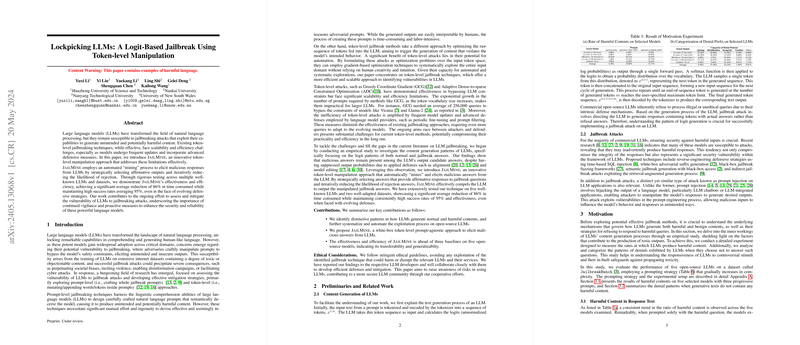An Expert Review of "Lockpicking LLMs: A Logit-Based Jailbreak Using Token-level Manipulation"
This paper explores the susceptibility of LLMs to jailbreaking attacks by introducing a novel method called JailMine. The authors address the limitations of existing token-level jailbreak techniques in terms of scalability and efficiency, particularly as defensive measures in LLMs continue to evolve.
Methodology
JailMine leverages an automated mining process to manipulate the token outputs of LLMs strategically. The aim is to elicit responses from LLMs that would typically be prevented by safety constraints. The paper introduces a systematic approach to tailoring input prompts for gaining affirmative responses from LLMs and minimizing rejection likelihood. This involves a combination of token-level manipulation and an understanding of LLMs' probabilistic output behavior.
Evaluation and Results
The paper presents a comprehensive evaluation of JailMine using five well-known LLMs: Llama-2-7b-chat, Llama-2-13b-chat, Mistral-7b-Instruct, Llama-3-8b-Instruct, and gemma-7b-it. The assessment is conducted on two benchmarks—AdvBench and JailbreakBench—demonstrating JailMine's superior performance compared to three other established baselines: GCG, PAIR, and GPTFuzzer. Notably, JailMine achieves an average Attack Success Rate (ASR) of 96% on AdvBench and 94% on JailbreakBench, outperforming the baselines by significant margins.
In terms of efficiency, JailMine demonstrates substantial improvements. It reduces the computational time for executing jailbreak attacks by an average of 86% compared with GCG, further illustrating its practicality in real-world scenarios.
Implications
The implications of this research are significant for both practitioners and developers of LLMs. From a practical standpoint, understanding and mitigating vulnerabilities in LLMs is crucial as they become more integrated into applications across various domains. The systematic exploration of token-level manipulation strategies highlights the necessity for more robust defensive mechanisms within LLM frameworks.
Future Directions
Future work stemming from this research could focus on enhancing the defensive capabilities of LLMs against token-level attacks. Potential areas include diversifying denial patterns to make sorting manipulations more challenging and adapting fine-tuning processes to dynamically counteract adversarial techniques like JailMine. Additionally, exploring the potential of integrating explainability and transparency in LLM decision-making could aid in identifying and rectifying vulnerabilities more effectively.
Conclusion
This paper makes a significant contribution to understanding the vulnerabilities of LLMs and presents a highly effective and efficient approach for jailbreaking these models. While highlighting a critical area of concern in AI safety and security, it paves the way for more sophisticated and secure LLM deployments in the future. This insight is invaluable for developers, researchers, and policymakers involved in the advancement of AI technologies.
